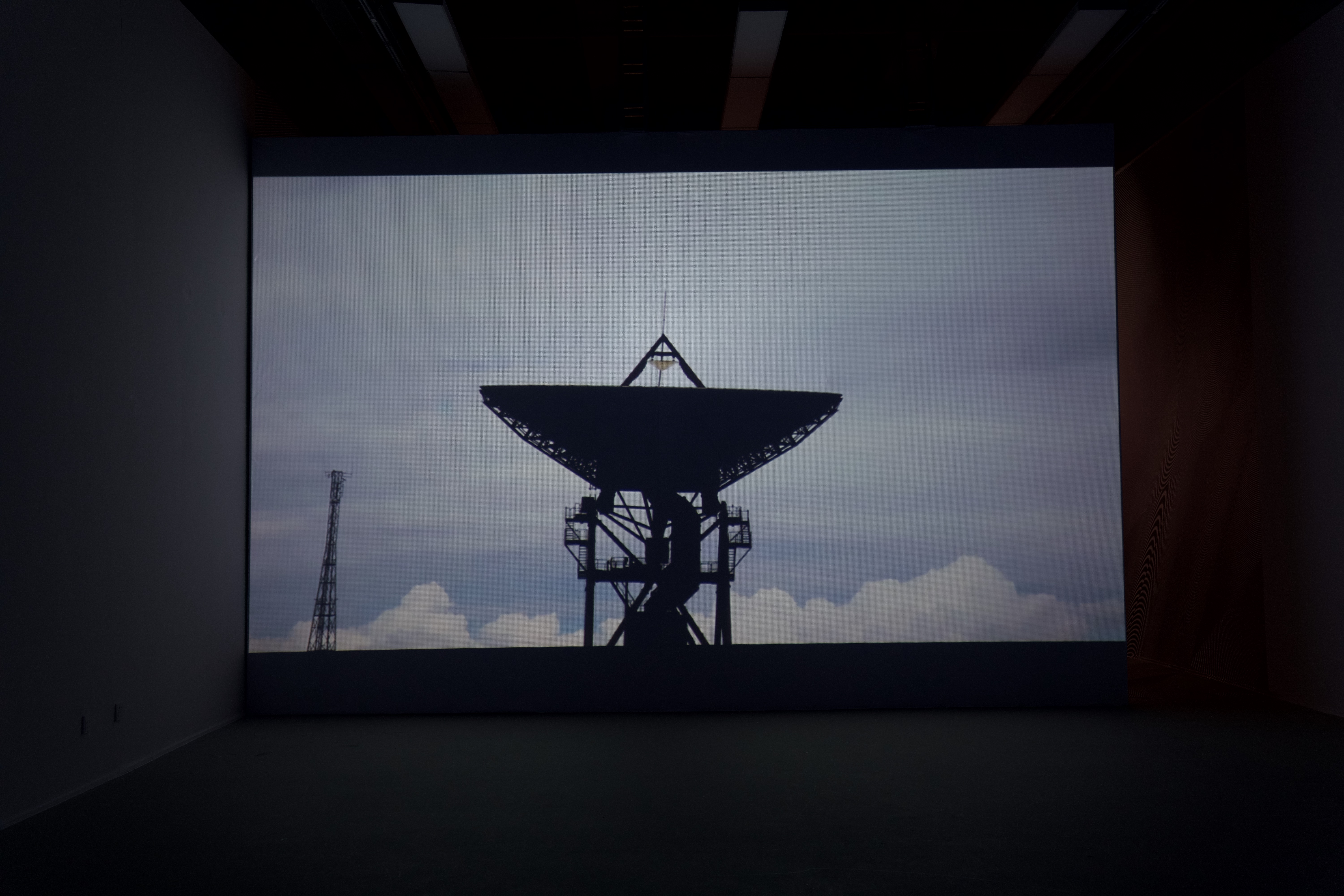Temporal Stack: the Deep Sensor
时满时空,深层感应
27 OCT 2021 - 07 NOV 2021

temporalstack.com
策展人 CURATORS
龙星如 Iris LONG 贺子珂 HE Zike
艺术家 ARTISTS
陈沾衣,Dennis de Bel,Daniela de Paulis,Dries de Poorter,郭城,The Nomadic Department of the Interior (NDOI),Rosa Menkman,Semiconductor,张文心,周元杰
在这片土地上,人的感知方式会因地质而产生,并为地质所确证。在这片中空的喀斯特土地上上,历史记忆如流水一般,毫无征兆地消失,随后带着全新的力量,以另一个名字于另一个地方重新出现。
——《深时之旅》,罗伯特·麦克法伦
喀斯特地貌向地心之深印刻着一种隐秘而漫长的时间:岩矿溶蚀形成地下的中空,暗河在其间时隐时现。在贵州地区,喀斯特像一种时间的压缩饼干:它既穿梭起关于古生物化石、棺葬和地下世界的民族传说,也承负着极为近现代的一系列科学技术设施的运转,这包括数据中心和世界上口径最大的单天线射电望远镜。地质结构的深时沉淀来自于外部扰动的消除,不论这些外部扰动是来自探险者,迷路误闯的旅人,还是电磁或泥石流。镶嵌在这一极其稳定的地质结构上的科技基础设施,也通常隐没于人们的视界边缘,成为更像“地貌”而非生活日常的存在。
《时满时空:深层感应》从带有隐喻属性的“深时沉淀”和与之相关的心理时间出发,试图在贵州的现场复现一条抽象的洞穴,一道无星暗河,串联起10位(组)艺术家关于地质地貌、基础设施和时间堆栈的意识枝桠。如Jussi Parikka所言,我们当下的时间尺度(timescale),是由诸多“不止人类”(more than human)的他者共同谱写的——这流淌于参展作品之间的共识与共情。作品的触角从地底出发,直叩深空,并在人、动物和科学仪器的不同视觉光谱之间,对我们所共处之地一次次、一层层地成像。张文心构建的一系列多孔空间隐秘追踪着蚁群、基础设施、古墓小说和魏晋道人,郭城针对封存在人造地质物(混凝土)中的信息残片展开一段幽灵狩猎,德瑞斯·德·波尔特则将展厅地表变成了一个声音地道的入口,将贵州和与之相对的另一个世界天文观测重地智利轻巧地相连。游牧水土资源部则具象地回应着大数据基建给土地和人带来的变化,追踪隐匿于山洞中的数据中心和“中国数谷”中的科技广场,在离散的碎片里,拼贴一段关于当下的现实科幻。艺术家同样狩猎着地表与天穹之间看似空洞无物的地带,丹尼斯·德·贝尔用自制的网络通讯装置监听周遭的波段,陈沾衣用业余无线电接收装置截获气象卫星图像并试图拼接一个“清晰的故障”,丹妮拉·德·保利斯则探向地月之间的中空,她使用月面无源发射通信技术,将1972年在月面留下的宇航员全家福发射回月球,这一过程中,月球成为了一颗被动的卫星。当目光继续向深空行进,罗莎·门克曼和半导体小组寻找着一种人之视野和科学技术设备的光谱之间的偏振:科学图像和宇宙学解释的缝隙之间,是否可以反观人类观察者的蛛丝马迹,甚至偶然间使我们与看似冷漠的“宇宙时间”产生亲密感?
展览通过层层迭进,将围绕互联网、数据、“云上”和脉冲星信号的述说,反向折叠回支撑这些抽象概念的基础设施系统,以及更为底层的自然:河流、山脉、洞穴、地层。展厅则在隐喻意义和在地形态上都成为了一个现代洞穴——下沉并包裹于由石块和沙土所讲述的在城市建设、地产开发和地貌演化中的混合叙事。当水做的云和数据之云,地质之洞和信息栈道合二为一,时满时空的喀斯特中空,以其永续沉淀的时间,让包裹着世界与日常的绝对宿命感开始逐步显现。这片深时沉淀也是一个激发创造力的地带,正如Anna Tsing等人在“人类史的人类学做法” 所言:“大叙事往往栖身于似乎微不足道的意外,不对称的邂逅和未曾确定的瞬息之间。”[1]


“Here in this hollow terrain of the karst, historical memory behaves like flowing water, disappearing without warning, only to resurge under new names, in new places, with fresh force.”
-Underland, Robert McFarlane
The Karst landscapes inscribe a secret and endless kind of “time” towards the earth’s core: the solutional processes have led to a hollow, negative-form space under the earth’s surface, within which underground rivers flicker in view. In Guizhou area, the Karst geology becomes a compressed biscuit of “time”, interweaving traces of paleontological fossils, native legends about cave burials and underground worlds, also bearing a series of “tech-infrastructures”, ranging from data centers to the Five hundred meter Aperture Spherical Telescope. The incredible stability of such a geological “compressed biscuit”, or sediment of deep-time, results from the elimination of external disturbances - no matter from adventurers, travelers who lost their way, electromagnetic radiation, or even debris flows. Inset into the Karst geology, the most reliable structural support, the tech-infrastructures seem to resemble “landscapes” more than parts of daily life.
The exhibition “Temporal Stack: the Deep Sensor” sets out in search of a metaphorical “deep-time sediment” and the psychological time associated with it. The show attempts to create an abstract cave tunnel, a starless river with artworks from 10 groups of artists that investigate notions of geology, infrastructure, a plurality of time, and branches of consciousness. In Jussi Parikka’s words, our current situation “engages timescales orchestrated by a range of more-than-human others” and this can be detected from the exhibiting artworks, the antennas of which spread from deep under the earth’s surface to the visual vanishing point in the sky, creating multilayered interpretations and sensations of our current world via the dynamics among human, animals and scientific apparatuses. In Zhang Wenxin’s work, the cave becomes an apparatus that links reservoirs, karst caverns, Daoist temples, mountain forests, and cities, passing through complex concealed topographies. With Ambers, Guo Cheng conducts ghost hunting towards artifacts/technical objects that were solidified in artificial “stones” (concrete). Dries de poorter converts the exhibition site into the entrance of a portal, connecting Guizhou with its opposite side of the southern hemisphere: Chile, which coincidently is also also a world center of astronomical observation. The Nomadic Department of the Interior (NDOI), meanwhile, investigates how techno-infrastructures reshape everyday life in Guizhou, with their visual travelogue, from data centers tunneled into mountains and new tech plazas in China’s Big Data Valley, brief fragments of which are transformed into a kind of “realistic science fiction”.
The “void” in-between the earth and sky also becomes a target of techno-ghost-hunting. Dennis de Bel secretly detects the invisible “wavescapes” with his Walkie-talkies. Chen Zhanyi receives image signals from a Russian weather satellite Meteor M2 with her amateur antenna, stitching all the images to get a clear, perfect glitch. Daniela de Paulis, meanwhile, uses the Visual Moonbounce technology to reflect the family portrait off the surface of the Moon, left by NASA astronaut Charles Duke in 1972. The moon becomes a passive satellite. Moving beyond the “edge of the sight”, Rosa Menkman and Semicondcutor seek the polarization between human visual spectrums and the parameters of scientific apparatuses. Would there ever be traces of human observers detectable on the cracks of scientific images and explanations of our world? Would those traces create intimacy between us and the indifferent cosmic time or rules? Layer upon layer, the exhibition unfolds the abstract narrations about big data, “cloud” or cosmology, and in reverse folds them into the infrastructures supporting such notions, and what supports the “infrastructures”: rivers, valleys, caves, stratum.
The exhibition space thus metaphorically and morphologically becomes a modern cave residing in the local context - sunken and wrapped in a hybrid story of urban construction, real estate development and geomorphic evolution in the words of the stone and sand. When the clouds made of hydrones and the “clouds” composed of bits merge with each other, when the geological tunnel gently overlaps with the information channels, technology and nature seem to arrive at symbiosis in one narrative. Sediment of time gradually fills the looming Karst hollow, where a kind of “absolute fate” encapsulating all - the world, the dailiness - slowly emerges. This “temporal stack” is also a zone of creativity, as Anna Tsing has smartly put it: “Big stories take their form from seemingly minor contingencies, asymmetrical encounters, and moments of indeterminacy”.[1]
[1] Gan, E., A. Tsing, H. Swanson, and N. Bubandt. 2017. Introduction: Haunted Landsca p es of the Anthropocene. In Arts of Living on a Damaged Planet, edited by A.Tsing, H. Swanson, E. Gan, and N. Bubandt, G1–G14. Minneapolis: University of Minnesota Press
